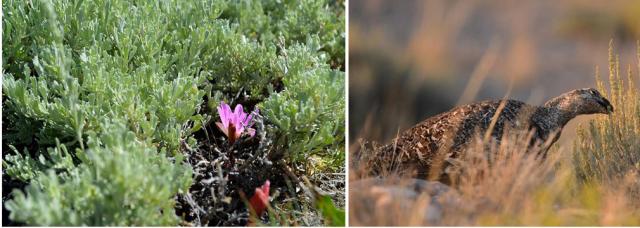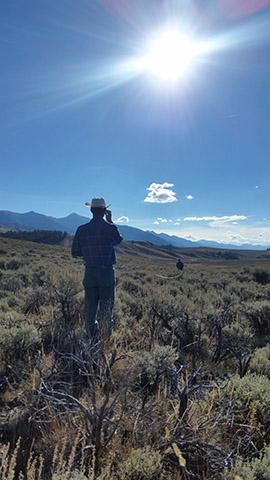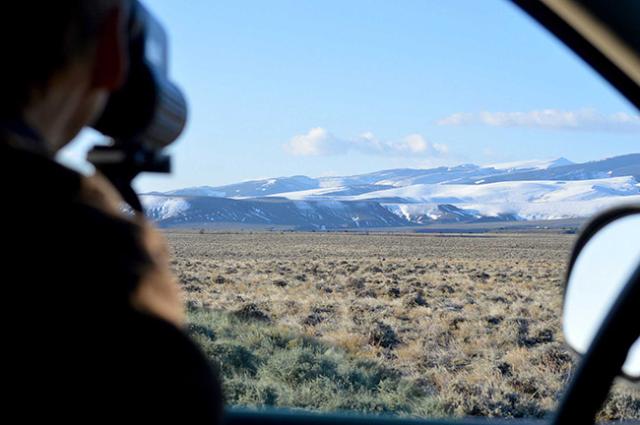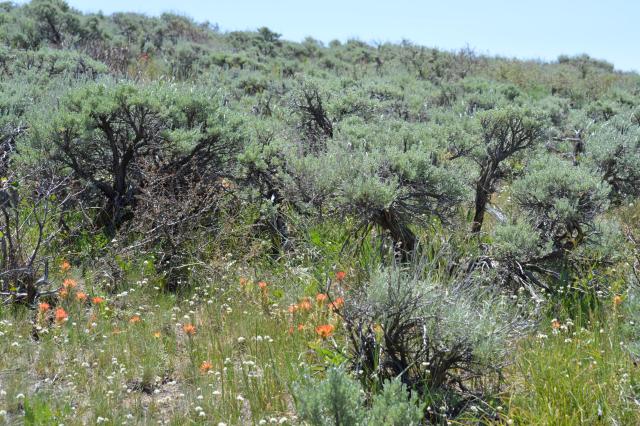You are viewing ARCHIVED content published online before January 20, 2025. Please note that this content is NOT UPDATED, and links may not work. Additionally, any previously issued diversity, equity, inclusion or gender-related guidance on this webpage should be considered rescinded. For current information, visit https://www.blm.gov/blog.
More than the numbers: Evaluating progress for sage-grouse conservation
As manager of the single-largest share of U.S. sagebrush habitat, how does the BLM know whether its decisions and actions are protecting these lands in ways that support healthy populations of greater sage-grouse?
Using the best available science, the plans adopted in 2015 for managing sage-grouse habitat on BLM-administered lands laid out seasonal objectives for conditions on these lands to ensure that they are providing the cover, food and security needed to support local sage-grouse populations during the various phases of their lifecycle.

of both types of plant provide food for sage-grouse in season. Sagebrush are slow-growing, taking
years or even decades to fully mature. | USFWS / Jennifer Strickland, Tom Koerner
Specific seasonal indicators were quantified and adjusted according to local science and data. In this way, the objectives represent the vegetation conditions the agency strives for across the sagebrush landscapes it manages.
Each year, sage-grouse cycle through springtime breeding and nesting, brood-rearing in summer, and activities necessary to survive winter. The intervals and duration of these seasons vary by location and from year to year, and may undergo rapid change with ongoing climate effects.

grouse are a BLM-Sensitive/Special Status species in States where they occur. | Gerrit Vyn/Cornell
Lab of Ornithology; USFWS/Tom Koerner
The same can be true for the indicators themselves and of the desired conditions identified in each plan. Climate effects such as extended droughts and unpredictable events such as wildland fire can disrupt trends in the growth and resilience of sagebrush, native grasses and the forbs sage-grouse eat, while hastening invasion by annual grasses like cheatgrass. Encroachment of conifers like juniper and pinyon pine can shade native understory, divert water and give roosting advantages to predators.

On the right, conifers can also move into sagebrush-steppe areas and change the ecological function in ways that
do not favor sage-grouse. | USFWS/Jennifer Strickland; NRCS/Tracy Robillard
To gauge whether habitat objectives are being met or are making progress toward being met, the BLM monitors the specified indicators to spot developing trends and changes. Data gathered during monitoring answers questions like, Are native grasses and sagebrush growing tall and densely enough to provide adequate cover for sage-grouse? Are there enough healthy sagebrush and other types of native plants to provide food? Is the vegetation around leks the type and condition favorable for breeding and nesting?

of vegetation at representative spots in designated areas. Here, a monitoring
team lays out a transect along which they will collect data on vegetation and soil. | BLM photo
BLM monitoring data and population data collected by state wildlife agencies are combined to evaluate the effectiveness of the management plans: Are they and the decisions and actions the BLM is taking under them achieving the desired conservation goals? In a scientific sense, effectiveness monitoring also allows better understanding of how changes in habitat from both natural events and management actions can be linked to the vitality of sage-grouse populations.

Monitoring data is checked against thresholds set in each of the management plans. If these threshold levels of habitat condition and population loss are exceeded, the BLM may be required to change, or adapt, certain management actions. Soft thresholds signal the need to apply more conservative measures, project-by-project, to reverse downward trends.
Adaptive management actions do not equate to determinations that any specific action was a direct cause of a trigger being tripped. Rather, modifying management action(s) when a soft threshold is exceeded is intended to prevent crossing a hard threshold. At that point, the plans say, immediate action is needed to stop a “severe deviation” from habitat or population objectives.
The BLM is committed to reversing long-term downward trends in sage-grouse populations and habitats in keeping with our multiple-use and sustained yield mission, to benefit sage-grouse, as well as the people who rely on sagebrush landscapes to support their livelihoods and traditions. Land use planning now underway is working to determine whether management actions like habitat objectives and adaptive management triggers in the 2015 sage-grouse plans are as strong as necessary to support conservation and restoration of sagebrush habitat on public lands.

that flowers in season. | USFWS/Jennifer Strickland
Relying again on science and continuing to work closely with all partners in the cooperative fashion that has served us well for more than a decade, we’re building responsive actions that protect this habitat now and preserve its values to hand on to future generations.
LEARN MORE: Next steps for sage-grouse | Documents & Background
Heather Feeney, Public Affairs Specialist
Related Stories
- Progress on Public Lands: BLM 2025 Trump Administration Accomplishments | January 20 - December 31, 2025
- Popular posts: BLM's most viewed blogs of 2025
- “Where did my horse come from?” BLM launches a new way for adopters, trainers and others to learn about their wild horses and burros
- Lake Havasu Fisheries Improvement Program is the gift that keeps giving
- BLM is thankful for public lands volunteers
